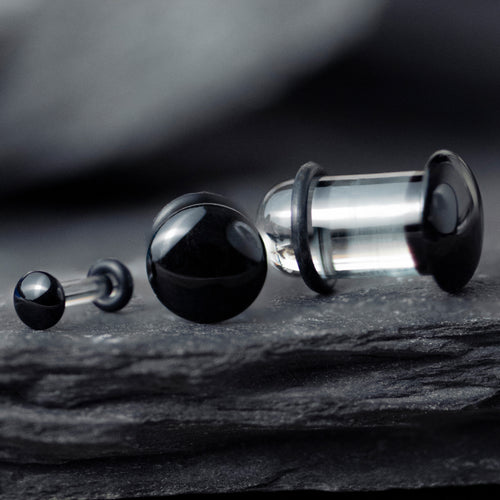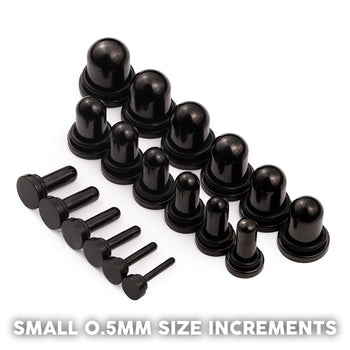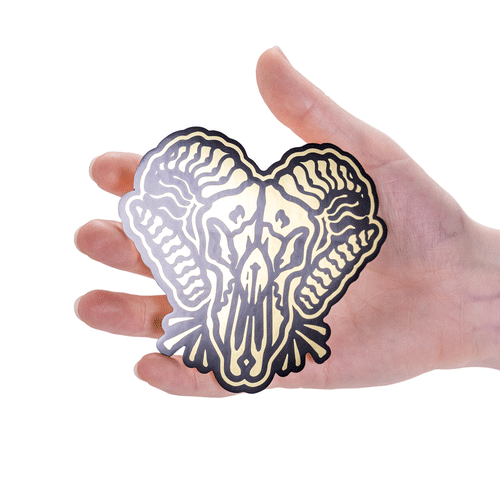
GET SOCIAL WITH US
RECENT ARTICLES
Newsletter
Keep up-to-date with the latest promotions, news and releases!
A Guide To Piercings with Custom Plugs
The General Piercing Guide: Everything You Need to Know

Piercings have been a part of human culture for centuries, serving as symbols of beauty, tradition, and personal expression. Whether you're considering your first piercing or adding to your collection, it's crucial to understand the process, aftercare, and potential risks involved. In this comprehensive guide, we'll delve into the world of piercings, covering everything from choosing the right piercing studio to proper aftercare techniques.
Before Getting a Piercing
Choosing a Piercing Studio
Research reputable piercing studios in your area and look for studios that prioritise cleanliness, professionalism, and adherence to safety standards.We recommend checking reviews and asking for recommendations from friends or online communities. Ensure that the piercer is experienced, certified, and knowledgeable about proper piercing techniques.
Selecting the right piercing
Consider your anatomy, lifestyle, and personal style preferences when choosing a piercing. Research different piercing types and their respective healing times, pain levels, and risks. Consult with your piercer to determine which piercing will best suit your features and lifestyle.
Preparation Before Your Appointment
Eat a healthy meal and stay hydrated to help reduce the risk of fainting or dizziness during the piercing. Avoid alcohol, caffeine, and blood-thinning medications before your appointment. Arrive on time and bring valid identification, especially if you're a minor.
The legal age for getting a piercing varies depending on the location. In many places, you must be at least 18 years old to get a piercing without parental consent. Some studios may pierce minors with parental permission and presence.
Choosing a Piercing

When choosing the right piercing, consider your anatomy, lifestyle, pain tolerance, and personal style preferences. Research different piercing types and their respective healing times, risks, and maintenance requirements. We recommend consulting with a professional piercer to assess your suitability for specific piercings and receive personalised recommendations based on your individual needs and goals.
Ear Piercings
Ear piercings are among the most popular and versatile options, offering numerous placement possibilities and jewellery styles. Common ear piercings include lobe piercings, helix piercings, tragus piercings, conch piercings, and daith piercings. Consider factors such as your ear shape, lifestyle, and personal style preferences when choosing an ear piercing.
Facial Piercings
Facial piercings allow for bold statements and can accentuate facial features. Popular facial piercings include nose piercings, eyebrow piercings, lip piercings, septum piercings, and cheek piercings. Take into account your facial anatomy, symmetry, and desired aesthetic when selecting a facial piercing.
Oral Piercings
Oral piercings are placed in and around the mouth and require special care due to the risk of infection and damage to oral tissues. Common oral piercings include tongue piercings, lip piercings (labret, Monroe, snake bites), and smiley piercings. Consider the potential impact on speech, eating, and oral hygiene before choosing an oral piercing.
Body Piercings
Body piercings offer endless possibilities for creative expression and adornment. Popular body piercings include navel piercings (belly buttons), nipple piercings, surface piercings, and genital piercings. Take into account factors such as clothing preferences, comfort, and potential visibility when selecting a body piercing.
Specialty Piercings
Specialty piercings encompass unique and unconventional placement options that cater to individual preferences. Examples of specialty piercings include dermal piercings, industrial piercings, and genital piercings such as Prince Albert and VCH (vertical clitoral hood) piercings. Consult with an experienced piercer to discuss feasibility, anatomy considerations, and aftercare requirements for specialty piercings.
During The Piercing Process

Consultation and marking Your piercer will begin by discussing your desired piercing and assessing the anatomy of the area. They'll mark the precise location of the piercing using a surgical pen, taking into account factors such as symmetry and placement preferences. This step is crucial to ensure the piercing is positioned correctly and complements your features.
Sterilisation and preparation
Your piercer will thoroughly clean the piercing area with an antiseptic solution to reduce the risk of infection. They'll also sanitise their hands and put on gloves to maintain a sterile environment. The piercing instruments, including needles and jewellery, will be sterilised or packaged in single-use, disposable containers.
Piercing technique
Depending on the type of piercing and the piercer's preference, a sterile needle or piercing gun may be used. Needles are the preferred method for most piercings, as they create a clean, precise hole with minimal trauma to the tissue. Your piercer will use gentle but firm pressure to insert the needle through the marked spot, followed by quickly inserting the jewellery.
Sensations and Pain
The sensation of getting pierced varies from person to person and depends on factors such as pain tolerance and the location of the piercing. Most people describe the feeling as a quick pinch or pressure, similar to a sharp sting. While it may be uncomfortable, the pain is usually brief and subsides quickly after the piercing is complete.
What to Expect After Getting a Piercing
After your piercing, your piercer will provide you with specific aftercare instructions tailored to your piercing type and location. Typically, you'll be advised to clean the piercing twice daily with a saline solution or a gentle, fragrance-free soap.
Use a sterile cotton swab or gauze pad to apply the cleaning solution, gently removing any crust or debris around the piercing site. Avoid rotating or twisting the jewellery, as this can disrupt the healing process and introduce bacteria.
It's normal to experience some discomfort, swelling, and redness in the days following your piercing. Over-the-counter pain relievers like ibuprofen can help alleviate pain and reduce inflammation. Applying a cold compress or ice pack to the piercing area can also provide temporary relief from swelling and discomfort.
While mild redness and swelling are normal during the initial healing period, it's essential to monitor your piercing for signs of infection. Common signs of infection include increased pain, persistent redness, warmth to the touch, excessive swelling, and yellow or green discharge.
If you notice any signs of infection, contact your piercer or healthcare provider immediately for further evaluation and treatment.
Healing times vary depending on the type of piercing, its location, and individual factors such as overall health and lifestyle. On average, most piercings take anywhere from a few weeks to several months to heal completely. Be patient and consistent with your aftercare routine, and avoid changing or removing the jewellery prematurely, as this can delay the healing process.
For more information on piercing aftercare, read our detailed piercing aftercare blog!

Changing Jewellery and Keeping Up with Trends
If you wish to change your piercing jewellery, wait until the piercing is fully healed to avoid disrupting the healing process. When changing jewellery, make sure to use clean hands and sterile tools to minimise the risk of infection. Choose high-quality, properly sized jewellery that fits comfortably and securely in the piercing.
If you decide to remove a piercing, clean the area thoroughly and gently remove the jewellery. Allow the piercing hole to close naturally, and avoid forcing or manipulating it. In some cases, scar tissue may remain after removing a piercing, but it typically fades over time.
Browse Body Jewellery at Custom Plugs
Piercings can be a beautiful form of self-expression and a way to adorn your body with unique jewellery.
By choosing a reputable piercing studio, following proper aftercare guidelines, and being mindful of potential risks, you can enjoy your piercing experience safely and confidently. Remember to listen to your body and consult with a professional if you have any concerns or questions throughout the process.
Browse our range of body jewellery today, here at Custom Plugs.



-v1657710003014.jpg?512x640&transform=resize=350)






























